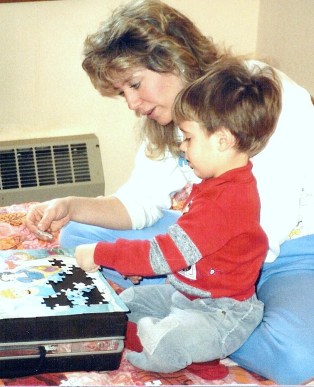Previously published in Christian Parenting Today magazine.
Puzzles can offer a window into your child’s mind, helping you see how he thinks and problem solves.
♥

I still remember learning about the way my child thought logically through problems as we worked this puzzle together, many years ago. (Ignore the 80’s hairdo!)
Puzzles can be a fun diversion. But do you know that they also will help your child develop the following skills?
* color, shape, and pattern identification and matching,
* recognition of integrated parts, and their relationship to the whole,
* fine motor skills and eye-hand coordination,
* problem solving skills, and
* the ability to make choices independently (even when uncertain about the outcome) with self-confidence.
In my occupational therapy work with young elementary school children, I often used picture puzzles. Puzzles can be used to teach kids new skills and also offer a window into a child’s mind. Watching a child and having him verbalize what he’s thinking helps you to better understand his ability to problem solve.
Following are eight developmental stages in puzzle problem solving, which I believe children move through sequentially, from preschool through elementary school. Thinking about the stages your child has passed through (and the stage he is currently in) will help you choose appropriate puzzles for him.
Understanding how your child is thinking makes playing with him more exciting, as you see him go from one stage to another. This also may give you clues as to how your child problem solves in general, which may affect his schoolwork as he grows older.
Let’s begin, using a typical preschool puzzle (separate holes for each piece; differences in shape are obvious), with:
1) HOLE FILLING: A very young child discovers that holes in a puzzle can be filled with loose pieces. She usually tries to push all pieces in all holes (regardless of color or shape) to “make” them fit.
2) MATCHING HOLES AND PIECES: She now realizes that each hole has only one corresponding piece. Tends to rely on color to find the correct one.
3) RECOGNITION OF DIFFERENCES IN SIZE and SHAPES: Your child now takes size and shape into consideration, looking closely at both holes and pieces. Finds the correct one more quickly. Does not yet understand turning a piece to make it fit, however (especially if small protrusions mean the piece fits only one way). May abandon the correct piece and try another, incorrect one.
4) MANIPULATION: She will turn a piece to see if it fits.
At any of the above stages, after completing a puzzle, your child may be able to re-do it easily alone by simply relying on her memory and fine motor skills. But she may now be ready to tackle a jigsaw puzzle, with interlocking parts and an outside boundary (cardboard back with raised edge on all sides), using the following skills:
5) INTERRELATING PIECES AND SORTING:
Your child sees relationships between pieces; begins to sort and group them by similarities in color and design. He is beginning to discern tiny differences between pieces; and may compare the puzzle pieces to the design printed on the box. Realizes the scale is different. May not yet understand significance of straight edges on the sides of some pieces.
6) VISUALIZATION and PART S V.S. WHOLE:
He now can “see” in his mind, how pieces will look together (i.e., pieces with a black line running through them, together will form one continuous line.) He sees individual sections, as well as the whole. (ex., clown puzzle: sorts out face pieces, even if different shapes and colors, then leg pieces, etc.)
7) MIRRORED OPPOSITES: She now does the above, but also with mirrored opposites. (i.e., a butterfly; wings pointing opposite directions.) Visualizes how pieces will look together; reverses images in her mind. Recognizes similarities despite reversed directions.
Now your child can move on to standard jigsaw puzzles, done on a table with no confining frame.
8) CORNERS AND EDGES (square puzzles): She realizes that two connecting straight edges, at 90 degrees, makes a corner piece. Know there are only four such pieces; will actively look for them. Realizes that only one straight edge indicates that piece will create an edge of the completed puzzle.
Note: Your child may be able to do a 70 piece jigsaw puzzle alone after trying it a few times with you, but still not understand corners and edges. He may still rely on visual memory (remembering how the puzzle looked when it was completed).
By the end of first grade, your child should progress through the first five stages (and may progress through all eight). If by fourth grade he still seems unable to grasp the concepts in stages 6 & 7, a learning problem might be indicated.
Watch your child do a puzzle. You can practically see how he thinks as he looks and sorts pieces. If he struggles, have him verbalize how he’s figuring it out. Resist the urge to tell where pieces go as you coach him. Model problem solving by asking questions: “How are these two pieces alike?” “This piece has a straight edge–where could it fit?”. Don’t forget to be cheerleader too, giving your child an enthusiastic “Yay!” when he’s successful.
Copyright © Laurie Winslow Sargent. Contact the author here for reprint permission.



One other issue issue is video games are typically serious in nature with the main focus on learning rather than fun. Although, it has an entertainment element to keep your children engaged, each one game is often designed to work with a specific group of skills or area, such as math concepts or technology. Thanks for your posting.
LikeLike
Laurie, I wanted to thank you for connecting with me via Bloggy Moms and Twitter! Looking forward to following along 🙂
-Megan @ {All Things New}
LikeLike
Thanks, God. It’s awesome blog. Laurie, would you, please, help me specify the number of pieces for each stage that is developmentally appropriate.
LikeLike